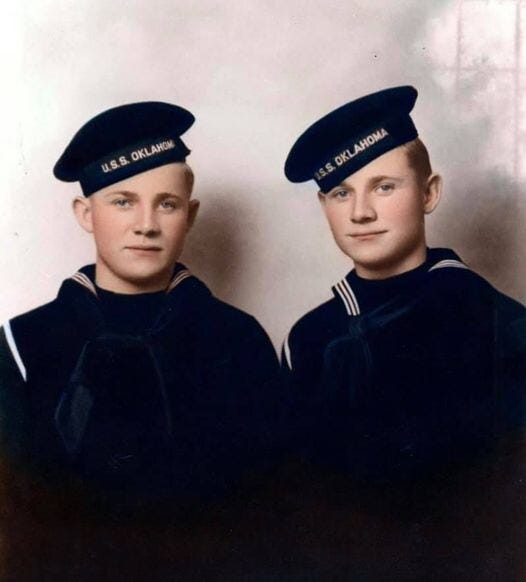Confession: This is a longish exploration. And I’m weird.
Late last year I came across a story from WW2 that riveted me. A tragic incident of war that sought closure 80 years later. Specifically, this article (and this, this and several others) described the gripping tale of how DNA techniques solved one of the final mysteries of Pearl Harbor, by identifying the remains of most of the crew of USS Oklahoma — the largest battleship sunk in the attack that day.
I was struck by this story, but also by how gargantuan WW2 losses were. And how each life, was a potential forfeited. Here’s a partial listing of some of those sailors…
Yet incredibly, the USS Oklahoma crew remained in mass graves until 2021. Then 80 years later, these sailors were identified and brought to their hometowns to be buried. There’s much about this saga that fascinated me. This poem arrived to capture my reaction and questions.
The law of large numbers
It’s the law of large numbers1 that the larger
the number, the greater our failure to account
for each coffin returned, imprisoned in
scant digits; so manageable they sound!
*
It’s said Blitz2 parents Henry and Marie
took to hanging in their window then on —
as if hailing their 1 and 2 in the millions lost —
a gallant banner with 2 gold stars.
*
8 battleships attacked that morning
USS Oklahoma the largest lost
Submerged, suspended in water
and oil, with its band of 429 ghosts
*
4 ships sunk, 2 others refused
recovery, in mourning for their crew
Pearl Harbor came to “live in infamy3”
First American casualties of WW2
*
America entered the war chanting
names of the 2,403 that perished then
The years rolled on, 4 more of war,
in a world thirsting revenge.
*
Patient men lay in an ocean tomb,
some 2 years later exhumed.
Dental records, dog tags, lucky marks revealed
35 names from vanishing clues.
*
The rest interred once more en masse
for 80 years in unmarked graves4
With loved ones clutching deathless rituals,
in unquenched mourning for their brave.
*
Until a sailor5 from a sister ship
pushed to account for more;
when a casket thought to be for 5 men
turned out to be a grave of 94!
*
Imploring miracles of modern science,
forensics, genealogy, genetics combined —
for questions that don’t perish with the dead —
mitochondrial, nuclear DNA, with dental files.
*
Science, memories, clues, some luck brought
5,100 samples from family and dead remains,
Returning 361 sailors for righteous rest
to soils from whence they came.
*
I read this story in fascination.
Why this clarion to bring our dead home?
On a time scale too vast for those who grieved
them; even their memories now long gone.
*
Was it just the need of a military sailor
to honor, bring to rest his star-crossed mates,
expiate that lifelong survivor’s sorrow,
all too often a war hero’s fate?
*
Or the demand of a nation to not forget,
leave unnamed, its soldiers dying unscored?
A fear they’ll vanish unnamed without
closure — a luxury war slogans can ill afford?
*
Those that go in manmade cataclysms, in wars
unaccounted in service of such horrors,
How many Einsteins, Mozarts, Gandhis are squandered?
How many freedom fighters, inventors, explorers?
*
Wasted dreams to build, tend gardens,
hearths, comfort the ailing, soothe a child.
Missing sons, brothers, fathers, beloveds
gaping shadows of forfeited lives.
*
Some say vacuums of loss travel through
generations, rarely spoken still persist
Impelling to bring our forebears home
laying inherited ghosts to rest.
*
Give me not then a misshapen goodbye, a
disembodied parting, an unclosed farewell.
So death, that final punctuation with dignified end,
a hope will be mine too, at ringing of the final bell
###
Reena | September 2023
I found in this exploration, a fascinating story of science, grit and humanity that began with the persistent demands of Ray Emory, a sailor who was on another ship (USS Honolulu) on the day of the attack. It resulted in the careful exhumation of remains, followed by DNA testing and matching with mitochondrial and nuclear DNA of living relatives, and combining that with a multitude of other clues such as dental records, dog tags, etc to accurately assign identities. As a result over 90% of the soldiers on the USS Oklahoma were identified.
Then they were brought home to their families.
Firstly, as I mentioned, the sheer brutality of war as captured in numbers. Every number in my poem is hence kept a number, not spelled out. I fear that when a number is too immense we fail to appreciate its magnitude, forgetting the untold small ones it’s composed of — each of which constitutes a person, a life, loved ones and a lost potential. As for the madness of war, I remain committed to the conviction that it should be permitted in very very very narrow and controlled circumstances.
418,500 Americans, 75 million lives lost in WW2
Secondly, I’m captivated by this need to bring our dead home, even those we never knew: the notion that after eight decades — nearly three generations past — the families, and the military united to bring these men home, even when most of those who knew and loved them were long gone!
Is it merely to ensure dignity in death for our soldiers? I grew up an Army brat so to me it seems like the righteous thing to do. But I suspect we’d demand such honoring for all of ours who die(d) away from home.
We humans are funny creatures. We don’t really know our forebears three generations past. We may not even care for them based on what we do know. Furthermore, we don't know what happens to us in death. And what’s the difference once we’re gone?
But the knowledge that we ensured a decent farewell for our departed gives us comfort. Perhaps also to assure us that when we go, we’ll be remembered with similar decency. That we won’t be forgotten no matter when and where our end arrives. Perhaps such knowledge gives us peace in our lifetime in the face of our finitude.
In my fascination, I read up a bit about the people involved. Sharing a few photos from that dig that serve as a reminder that these were people, just like you and me with love, concerns, contributions just like yours and mine…




Twins Leo Blitz, left, and Rudolph Blitz were on the USS Oklahoma when it was sunk in the 1941 attack on Pearl Harbor. These lines were for them:
Rudolph Blitz, Fireman 1st class, 20
who went looking below deck, for his brother
Machinist’s Mate 2nd class Leo Blitz, 20
Twins born, also perished as one, months from
turning 21 to ship out of harm’s way, if only








Throughout human history, there have been many wars and conflicts started mainly as a result of the greed, ego and geopolitical ambitions of a small group of leaders, who then steered their respective countries into war in order to achieve their personal agendas.
In that sense, it is quite disappointing that so many lives of ordinary people (soldiers & average citizens) were needlessly lost as a result of such wars and conflicts, which were mainly started in order to serve the agendas of those small group of leaders.
Instead, those leaders could've pursued a path of peace and mutual cooperation amongst each other and with their perceived "enemies", which at the end of the day, is truly the only way all nations and people on Earth can coexist and thrive.
What struck me is how the lady who wrote the letter was expressing how she was trying to, in a sense, keep herself together for everyone around her, to keep others from feeling depressed. I think the process of honoring those who have passed on is, like you said, a way of giving ourselves assurance that we have the possibility of being honored as well when we move into whatever the next realm is. Also, perhaps the honoring of the dead is a way of acknowledging that grief and everything that comes with it exists, that we do not have to be expected to hold ourselves together in the midst of great brokenness. The acknowledgement of grief and death is to allow ourselves to be fully human and express all that we need to within that process.